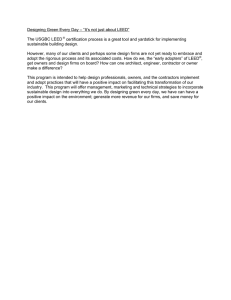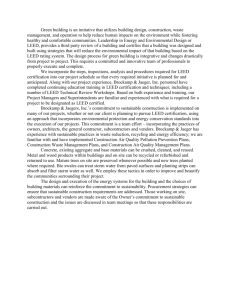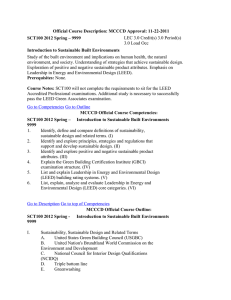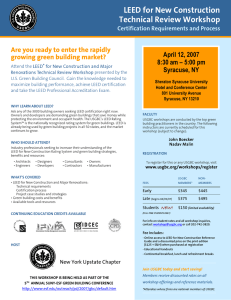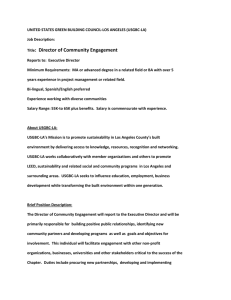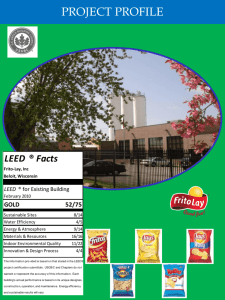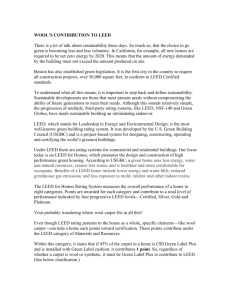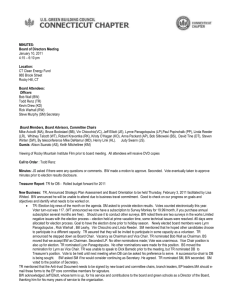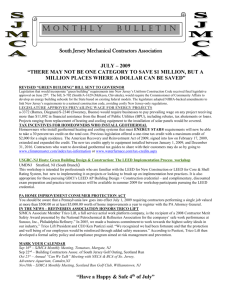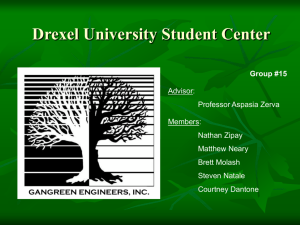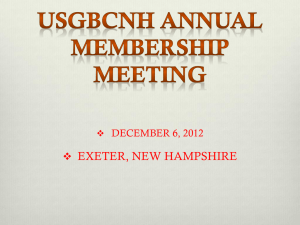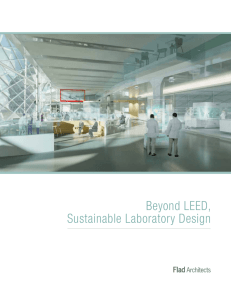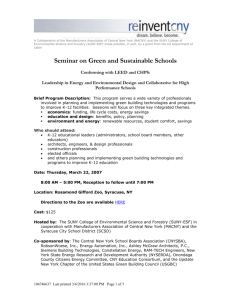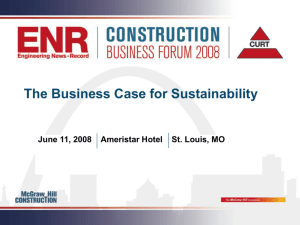Ctecc 4.indd - Central Texas
advertisement
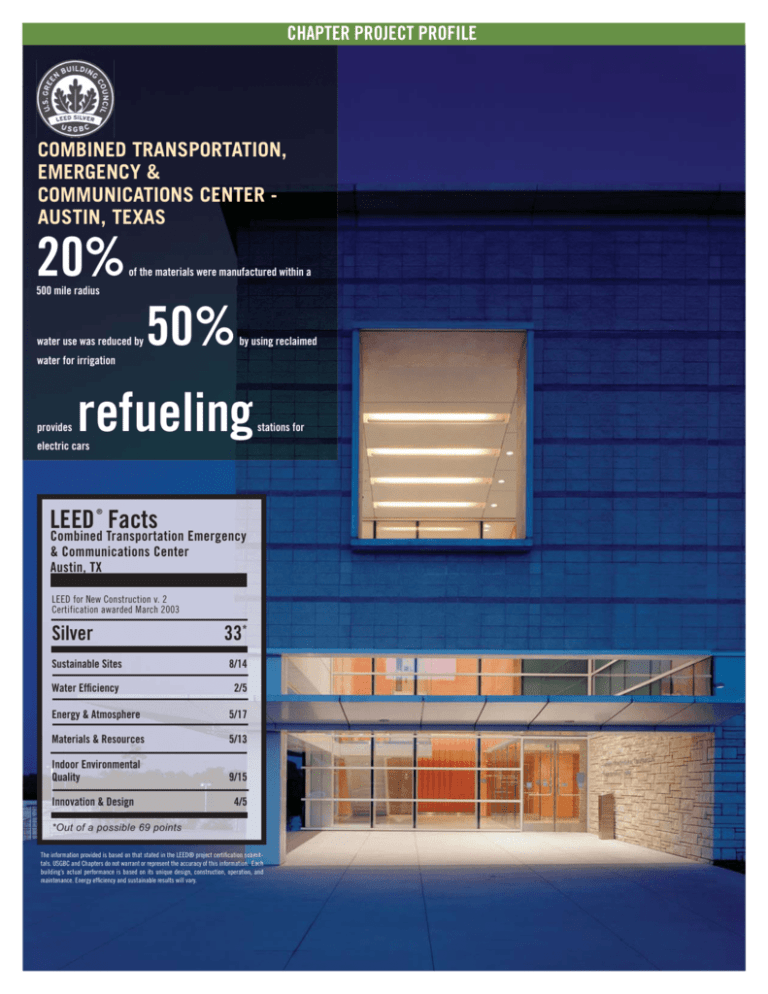
CHAPTER PROJECT PROFILE COMBINED TRANSPORTATION, EMERGENCY & COMMUNICATIONS CENTER AUSTIN, TEXAS 20% of the materials were manufactured within a 500 mile radius water use was reduced by 50% by using reclaimed water for irrigation provides refueling stations for electric cars ® LEED Facts Combined Transportation Emergency & Communications Center Austin, TX LEED for New Construction v. 2 Certification awarded March 2003 Silver 33* Sustainable Sites 8/14 Water Efficiency 2/5 Energy & Atmosphere 5/17 Materials & Resources 5/13 Indoor Environmental Quality 9/15 Innovation & Design 4/5 *Out of a possible 69 points The information provided is based on that stated in the LEED® project certification submittals. USGBC and Chapters do not warrant or represent the accuracy of this information. Each building’s actual performance is based on its unique design, construction, operation, and maintenance. Energy efficiency and sustainable results will vary. CHAPTER PROJECT PROFILE COMBINED TRANSPORTATION, EMERGENCY & COMMUNICATIONS CENTER CREATING MULTI-AGENCY, MULTI-JURISDICTICTIONAL COMMAND AND CONTROL PROJECT BACKGROUND The primary design requirements for the facility were to provide a highly efficient and functional space that allowed various public safety agencies within Austin and Travis County the ability to respond quickly in a combined and/or coordinated effort to emergency and other critical situations. A secondary requirement is to design spaces which aid in reducing the extreme stress and tension levels experienced by personnel working in these extremely demanding environments. STRATEGIES AND RESULTS To achieve a Silver LEED rating, the CTECC building employed a myriad of strategies. The project was built on a Brownfield redevelopment site. There are bicycle storage rooms and changing rooms to encourage different methods of transportation, as well as refueling stations for electric cars. The project design also reduced the footprint to minimize site disturbance, and restored native vegetation to the open landscape. In order to reduce heat islands, a portion of the black asphalt drive was replaced with a lighter colored, reflective concrete. The roof had a highly reflective, white membrane. There was a reclaimed water system installed for irrigation, and the water use for landscaping was reduced by 50%. Some of the features utilized to optomize energy performance included: low E windows, air handlers with variable speed drives, chilled water HVAC system, lighting motion sensors, photocells, dimmers. There was also additional commissioning planned to ensure systems continue to operate at optimum efficiency. The ceramic tile and space partitions were recycled, while 20% of the materials and products were manufactured within 500 miles. 50% of the material manufactured within 500 mile radius were harvested from a local quarry. The wood doors were certified veneer by the Forest Stewardship Council. Low emitting materials, including adhesives and sealants, carpet, composite wood (no urea-formaldehyde binders) were used. Also, there was an added controllability of the systems (workstations have Personal Environmental Modules (PEM) for individual control of comfort). The project achieved an Innovation in Design Credit for using ergonomic concepts for workstations on the operations floor. ABOUT COMBINED TRANSPORTATION, EMERGENCY, & COMMUNICATIONS CENTER The combined transportation, emergency & communications center (CTECC) is a regional “mission critical” public safety facility. CTECC supports the existing and new operations of critical emergency communications for the greater central Texas region. The secure operations center houses 151 public safety employees from four entities: the City of Austin, Travis County, Capital Metropolitan Transportation Authority, and the Texas Department of Transportation (this includes the police, fire, sheriffs, constables, emergency medical services, and a variety of other groups). In the event of an “emergency response” event where the Emergency Operations Center is activated, that number would climb to approximately 250+. The building was designed to be the shell that protects, encloses, and supports sophisticated electronic equipment along with the highly trained emergency communications personnel who manage the various emergency responce agencies. The building is an “essential facility” so that the dispatch areas and electronic equipment remain operational in case of severe storms, tornadoes, and other disturbances. The building was designed to withstand tornadoes with wind velocities of F-3 Category and is secure against manmade threats of explosive devices, small arms gunfire, vehicular breaches, and gases. © 2010 USGBC - Central Texas Balcones Chapter. Printed on 100% post consumer recycled, chlorine-free paper with non-toxic soy inks. Chapter is a separate Texas 501c3 nonprofit corporation. Architect, MEP Engineer and Fire Protection: Daniel Mann Johnson & Mendenhall Owner: City of Austin Acoustics: Jack Evans Associate Architect: Architecture + Plus Civil Engineer: Raymond Chan & Associates Commissioning Agent: ACR Engineering, Inc. Contractor: Bartlett Cocke, LLP Cost Estimating: ASD Consultants Integrator: Northrop Grumman Information Technology Landscape Architect: Winterowd Associates, Inc. LEED Consultant: Center for Maximum Potential Building Systems Lighting: Light Vision Structural Engineering: Jose I. Guerra, Inc. CM Advisor – Sunland Group Security – Kroll Schiff and Assoc. Project Size: 80,600 sq ft ABOUT LEED The LEED® Green Building Rating System™ is the national benchmark for the design, construction, and operations of highperformance green buildings. Visit the U.S. Green Building Council’s website to learn more. www.usgbc-centraltexas.org 512-470-9923

